In a new format for the Ghost Wrap podcast, I looked back on five important insights in the South African market from November 2024.
Listen to the podcast to get the details on these topics:
- The per-share numbers are what count in the property sector
- The market is hungry for quality IPOs
- Poultry businesses are making money again
- Murray & Roberts is a catastrophe
- MultiChoice really, really needs the Canal+ deal to go ahead
The Ghost Wrap podcast is proudly brought to you by Forvis Mazars, a leading international audit, tax and advisory firm with a national footprint within South Africa. Visit the Forvis Mazars website for more information.
Listen to the podcast here:
Transcript:
1. The per-share numbers are what count in the property sector
Property is back and in a big way, driven by decreasing interest rates and other very helpful trends like the return to office. The local property funds are focusing on optimising their local exposure (in many cases towards the Western Cape), while some of the European focused funds are back at it with capital raising activities – and that’s how you know things are getting better in the sector.
One of the ways to raise capital is to hang onto it. Yes, I’m talking about scrip dividends – giving shareholders the ability to choose to receive shares instead of cash. This is effectively a miniature rights issue, something that property funds just love doing.
The way that Sirius Real Estate has been raising capital is the good old fashioned way: accelerated bookbuilds, in which the advisors get their phones out and test the appetite for shares among institutional investors. At NEPI Rockcastle, recently activity has been the scrip dividend alternative. Regardless of which approach you look at, the net result is that there are more shares in issue than would otherwise be the case. Unless the capital can be deployed timeously into strong opportunities, this creates a near-term drag on performance.
For example, Sirius Real Estate grew funds from operations by 14.5% for the six months to September. That sounds fantastic on paper, but some of that is due to the deployment of capital. In other words, they went and bought some of this performance. The right metric to look at is always the per-share performance, because that’s what you care about as a shareholder. It’s easy to raise money and buy revenue, but was the money spent in the right way? Funds from operations per share actually fell by 5.5%. This is because of two substantial recent capital raisings and how long it’s taking to deploy the capital, particularly as Sirius is so popular with investors that they can raise money ahead of actually needing it. This is more common in the tech sector than the property sector. A war chest creates a cash drag effect on returns, so be cautious of that in this sector.
Over at NEPI Rockcastle, a business update for the first nine months of the year shows net operating income up 12.3% overall. On a like-for-like basis, it’s up 8.4% – so there’s a chunky gap there due to acquisitions. And here’s another chunky gap: the difference between net operating income growth and the expected increase in distributable earnings per share for FY24, which is just 5.5% – again, much lower than the rate at which the total group is growing.
Moral of the story: be wary of dilution at property funds. Just because the fund is doing really well over time doesn’t mean that your shares are doing well. In fact, if you held an equally weighted basket of NEPI Rockcastle and Sirius Real Estate this year, you would be feeling very disappointed with the lack of overall share price growth:
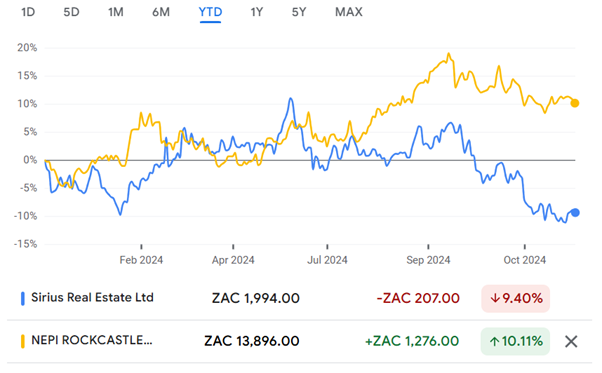
Those share price performances largely offset each other, which would leave you with only dividends to show for yourself.
2. The market is hungry for quality IPOs
This got so much attention during November that we don’t need to go into tons of detail here. Still, it would also be wrong not to mention it at all, so here’s the quick reminder that November was the month of Boxer’s listing as the most important story on the JSE.
Pick n Pay priced the capital raise for success, frankly because they couldn’t afford for it to fail under any circumstances. As the second step in the two-step recapitalisation plan, with the first step being a rights issue in the market, Pick n Pay needed to raise money efficiently from the sell-down of the Boxer stake, even if this meant leaving money on the table. That’s typically how IPOs work – the initial raise is priced competitively to create loads of interest among investors. Then, on the first day of trading, the share price tends to go up and the headlines are positive. That’s exactly what happened at Boxer, with Pick n Pay ticking its box of raising R8.5 billion and reducing its stake to 65.6%, while the Boxer management team ticked their box of getting a high-quality shareholder register and a successful listing.
Of course, all eyes will now be on Pick n Pay to see if they can actually turn the business around. Thanks to the lack of load shedding and the general improvement in SA Inc. sentiment, the share price has actually done very well this year as the market started to believe in a turnaround:
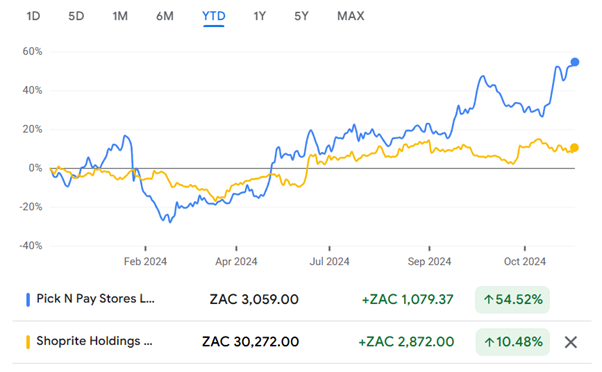
But if you look over 5 years, the story is completely different. The deviation in performance vs. Shoprite is breathtaking, showing the power of stock picking even in a market that might seem a little boring to you, like grocery retail:
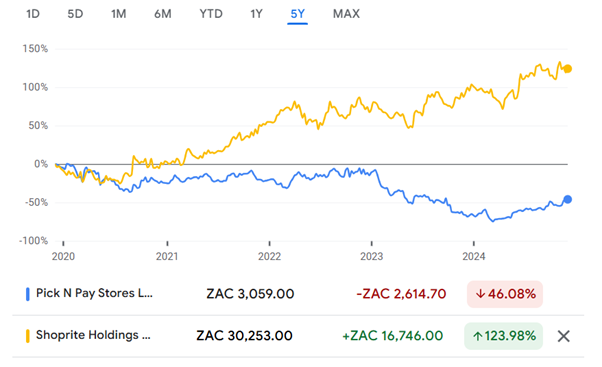
The really fun chart to draw a year from now will be Boxer vs. Pick n Pay and Shoprite. I think that the current price for Boxer is a pretty decent reflection of fair value, so I wouldn’t expect it to return much more than around 8% to 10% a year from here. Perhaps I’ll be pleasantly surprised.
3. Poultry businesses are making money again
This is very good news in a country that depends on chicken!
In a structurally low margin business like poultry, it makes a huge difference when things start to go well. Just consider Astral for a moment, with revenue up just 6% for the year ended September and yet a massive swing from a headline loss per share of R13.24 to HEPS of R19.20!
Thanks to cost containment and generally better operating conditions in the sector, a modest uptick in revenue dropped to the bottom line (as they say) and created a much healthier income statement.
Over at Quantum Foods, where there has been plenty of noise around shareholder activism and the behaviour of the board, revenue for the year ended September decreased by 8.9% – very different to Astral and on paper that’s a poor result. Despite this, HEPS swung from a loss of 17.4 cents to a profit of 80.4 cents – like at Astral, a huge positive swing. When you look at the segments, you see some other wild swings, like the eggs business which suffered a revenue drop of 35% and yet moved from an operating loss of R42 million to an operating profit of R140 million!
In these businesses with such tight margins, revenue isn’t always the best predictor of performance. Sure, it helps when revenue goes up, but here we have Astral and Quantum with two different revenue shapes in the past year, yet both registered a substantial improvement in profits. It’s more about what happens in margins further down the income statement. All you need is decent cost control or a little bit of luck and things can go well. Conversely, some bad luck, a change in input costs or, of course, load shedding, and things can go really badly.
4. Murray & Roberts is a catastrophe
Murray & Roberts is now suspended from trading. This is because the company is now in business rescue, based on forecasts of underlying performance and the immense debt burden that needs to be addressed by January 2026.
There are a lot of factors at play here, not least of all key client De Beers scaling back on its capex and leaving the Cementation business in crisis. One of the biggest risks in any business is key client dependency. Who would’ve guessed that the threat of lab-grown diamonds and the impact that is having on De Beers would then drive such a profound negative hit to Murray & Roberts?
The overall balance sheet pressures at Murray & Roberts has been a mess for the Optipower division, which has been incurring substantial losses that Murray & Roberts simply cannot afford. They currently owe R409 million to the banking consortium and that amount is due in January 2026. There is no room for subsidiaries to be making losses.
The share price chart this year really tells the story, down 25% year-to-date and with a terrible peak-to-trough. It has been suspended from trading at 110 cents per share and the 52-week high is around 330 cents per share, as recent as August 2024. That’s a horrible outcome for those who punted at this thing and have watched it wash away, with no guarantee that there will be equity value left at the end of the business rescue process.
It really is a mess.
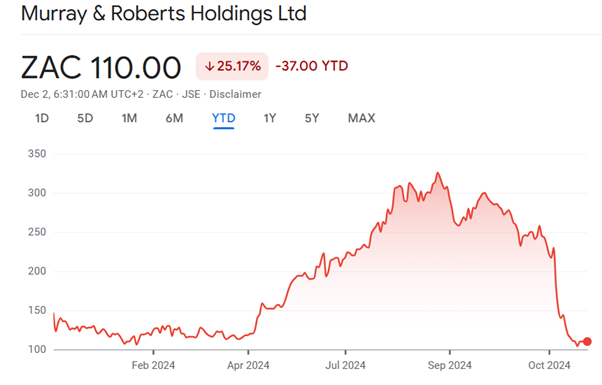
5. MultiChoic really, really needs the Canal+ deal to close
MultiChoice released an interim trading statement that called the current conditions the most challenging environment in the group’s history, setting the scene for the release of full results. With pretty decent numbers coming out of media sector peers eMedia (part of HCI) and African Media Entertainment (with a bunch of radio assets), I’m not sure that’s because the media industry is inherently broken. If anything, I think it’s because MultiChoice is betting everything on building a business for sale, not for profitability.
There’s a big difference between those two concepts. When building for sale, you’re chasing scale in a way that will be appealing to an international buyer. The investment in building out the African streaming technology is certainly relevant here, which is part of what attracted the eye of Canal+. Contrast this to a group like eMedia, which focuses on building slowly and surely within South Africa (rather than an empire across Africa), keeping costs at bay and being well prepared for an improvement as load shedding disappeared.
The problem at MultiChoice is that spending more and winning more subscribers aren’t the same thing. In my opinion, they are not getting the basics right. Subscriber numbers are down 5% in South Africa and 15% in Rest of Africa. That is a pretty scary statistic when you consider the extent of investment in Rest of Africa. The group now finds itself in a negative equity position and achieved adjusted core headline earnings of a paltry R7 million in the latest period – they are barely profitable!
At this stage, I have no idea what they will do if the Canal+ deal falls through. When you consider what Vodacom and Remgro have been through to try and get the Maziv fibre deal approved, I wouldn’t want my investment case to depend on regulators saying yes. More importantly, whether they say yes timeously, because MultiChoice doesn’t have a lot of time here based on current performance.

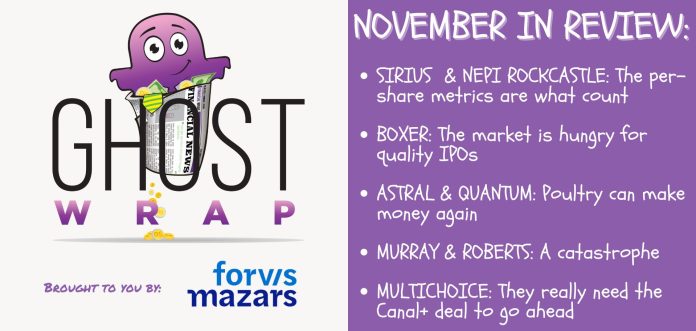


Hi Ghost,
Enjoy the new format, kind of keeps things focused and tied together more,
Thanks for the great work and trust you’re feeling a lot better again,
Great read and providing 5 topics of interest is great
Agree. I particularly enjoyed your article on per-share analysis. Please give us more of these “general investment analysis” articles
I enjoy the new format. It’s concise, focused and diverse. perhaps a second monthly podcast could be added for something different like small cap stocks or international stocks that are interesting.
I liked the new format, gives me better insight, thanks
Hi Ghost
Great idea, enjoying the format – good to have a quick high level overview of what’s happening out there & focusing on what’s relevant
I love the new format.